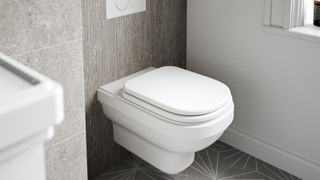Toilet Dimensions: Do You Have Space For An Extra Bathroom?
We take a look at the recommended toilet dimensions so that you can plan a bathroom or cloakroom that is not only stylish, but also practical

It might not be a glamorous topic, but the issue of toilet dimensions is an important one nonetheless. If you are designing a new bathroom, or cloakroom, you may well be wondering if it will be big enough for your needs.
This is often a particular concern amongst those trying to squeeze in a downstairs WC or an ensuite. While extra bathrooms are undoubtedly useful, sometimes there just isn’t enough space for them to be usable.
If you are mulling overbathroom design ideas不确定你是否有足够的面积to fit one in, our guide to toilet dimensions covers everything from standard sanitaryware sizes to the minimum clearance spaces required around toilets and sinks to help you get an idea of whether you can turn your dream of an extra bathroom into reality.
What Toilet Dimensions Do Experts Recommend?
This very much depends on the type of space you are hoping to create. If it is simply a cloakroom you are after, containing just a toilet and basin, the minimum size requirements will be very different to those required for a family or master bathroom. A minimum space for a cloakroom is 800 x 1,400mm (around 1.12m2).
You will also need to plan what items you want in your newbathroom designapart from the standard toilet and basin — bath, shower enclosure, storage furniture and so on.

What is The Minimum Size a Cloakroom Can Be?
When it comes to the minimum size of a cloakroom, it is not recommended you go any smaller than 700mm wide x 1,300mm long. That said, when thinking about yourdownstairs toilet ideas, do bear in mind that a far more comfortable space would measure 800mm x 1,400mm at the very least.
The average size of a cloakroom, according toVictoria Plum(opens in new tab), is 1200mm x 1200mm.
Is There a Minimum Bathroom Size?
While there are no set rules or regulations to state how small you can go with your bathroom design, there are a few factors to bear in mind.
A standard size bath, for example, measures 1,700mm in length — so if you want to incorporate one, you will need at least one wall to be at least this long. Of course, if you plan on fitting a shower enclosure instead, you can go a little smaller than this.
You will still need to bear in mind the sanitaryware clearance guidelines though to ensure you can use the space comfortably — plus if it isfamily bathroom ideasthat are on your mind you will want to ensure you have as much clear floorspace as you can get.

What is The Standard Size of a Toilet?
There is not a standard size of toilet as such, given the range of designs now on offer, from compact wall-hung designs to more traditional high-level cisterns.
When it comes to the popular close-coupled toilet design, however, most tend to have a similar height of between 380mm to 460mm. In terms of depth, anything from 400m to 750mm can be expected, with widths ranging from around 350mm up to 500mm.
More important than standard toilet sizes, however, is the clearance space around them.
What is The Minimum Space For Toilet?
It is important that you make yourself aware of the minimum clearance space required around a toilet before you can begin planning a bathroom.
The required space in front of a toilet is 510mm — although experts at Victoria Plum suggest that a space of 760mm is more desirable.
The required unobstructed span for a toilet is 760mm.
How Much Space Do Baths and Basins Require?
Of course toilets are not the only sanitaryware item you will need to take account of when considering your bathroom layout.
Bathroom basins need at least 510mm of space in front of them, although 760mm is better. A clear distance, from left to right, of at least 760mm is a requirement too.
When it comes to baths, you are required to leave at least 530mm of space to the side.

Get the Homebuilding & Renovating Newsletter
Bring your dream home to life with expert advice, how-to guides and design inspiration, direct to your inbox.
Natasha is Homebuilding & Renovating’s Associate Editor and has been a member of the team for over two decades. An experienced journalist and renovation expert, she has written for a number of homes titles. She has renovated a terrace and is at the end of the DIY renovation and extension of her Edwardian cottage. She is now looking for her next project.
Most Popular
Thank you for signing up to Homebuilding. You will receive a verification email shortly.
There was a problem. Please refresh the page and try again.
